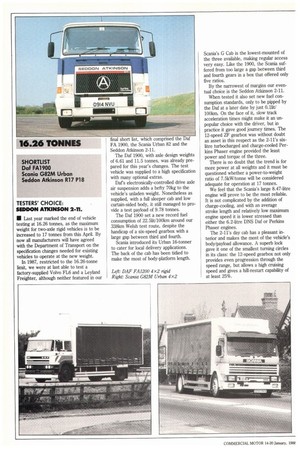IN Last year marked the end of vehicle testing at
Page 48

Page 49

If you've noticed an error in this article please click here to report it so we can fix it.
16.26 tonnes, as the maximum weight for two-axle rigid vehicles is to be increased to 17 tonnes from this April. By now all manufacturers will have agreed with the Department of Transport on the specification changes needed for existing vehicles to operate at the new weight.
In 1987, restricted to the 16.26-tonne limit, we were at last able to test a factory-supplied Volvo FL6 and a Leyland Freighter, although neither featured in our
final short list, which comprised the Daf FA 1900, the Scalia Urban 82 and the Seddon Atkinson 2-11.
The Daf 1900, with axle design weights of 6.61 and 11.5 tonnes, was already prepared for this year's changes. The test vehicle was supplied to a high specification with many optional extras.
Dal's electronically-controlled drive axle air suspension adds a hefty 70kg to the vehicle's unladen weight. Nonetheless as supplied, with a full sleeper cab and low curtain-sided body, it still managed to provide a test payload of 9.78 tonnes.
The Daf 1900 set a new record fuel consumption of 22.51it/100km around our 338km Welsh test route, despite the handicap of a six-speed gearbox with a large gap between third and fourth.
Scania introduced its Urban 16-tonner to cater for local delivery applications. The back of the cab has been tidied to make the most of body-platform length. Scania's G Cab is the lowest-mounted of the three available, making regular access very easy. Like the 1900, the Scania suffered from too large a gap between third and fourth gears in a box that offered only five ratios.
By the narrowest of margins our eventual choice is the Seddon Atkinson 2-11.
When tested it also set new fuel consumption standards, only to be pipped by the Daf at a later date by just 0.11it/ 100Icrn. On the face of it, slow track acceleration times might make it an unpopular choice with the driver, but in practice it gave good journey times. The 12-speed ZF gearbox was without doubt an asset in this respect as the 2-11's sixlitre turbocharged and charge-cooled Perkins Phaser engine provided the least power and torque of the three.
There is no doubt that the trend is for more power at all weights and it must be questioned whether a power-to-weight ratio of 7.5kW/tonne will be considered adequate for operation at 17 tonnes.
We feel that the Scania's large 8.47-litre engine will prove to be the most reliable. It is not complicated by the addition of charge-cooling, and with an average stroke length and relatively low maximum engine speed it is lower stressed than either the 6.2-litre DNS Daf or Perkins Phaser engines.
The 2-11's day cab has a pleasant interior and makes the most of the vehicle's body/payload allowance. A superb lock gave it one of the smallest turning circles in its class: the 12-speed gearbox not only provides even progression through the speed range, but allows a high cruising speed and gives a hill-restart capability of at least 25%. is Of the six multiwheelers tested we shortlisted three: the six-wheeled Leyland Constructor, the low-powered Foden and the heavy Hino 8x4 all lost out on a productivity basis.
From the two Fodens in our sample, both fitted with Gardner engines, we chose the more powerful of the two, accompanied by Scania's P92M 8x4 tipper and the Irvine-built Volvo FLIO.
Both the Scania and the Volvo have turbocharged and charge-cooled engines, while Foden, with the Gardner 6LXDT unit, derives similar levels of power and torque from a larger-capacity 12.7-litre turbocharged unit. Improved turbocharging has increased the 6LXDT power output from 201kW (270hp) to 216kW (290hp) without any increase in engine speed. While lighter than some competitive engines of almost three litres less capacity, the Gardner badge commands a premium of about 23,000 over other proprietary engines.
The Foden composite cab construction has proven popular among operators in the tipper sector.
It is not prone to rusting in the same way as a steel shell and it seems to stand any amount of hosing out. Slow to catch on at first, the Foden rear bogie's rubber suspension's advantages over steel suspension are now widely accepted for on/ off road applications.
In contrast, Scania clings to the proven four-spring non-reactive suspension incorporating numerous threaded pins and bushes which invite automatic lubrication. While Scania seems determined not to become party to discounting, it secures only a small percentage of this market — but makes a profit on every vehicle it sells.
Of late Volvo has contended strongly for leadership of the eight-wheeler market. Tipper operators seem to like the FL10's large cab which, with wipe-down surfaces and a flat floor-well, is easy to keep clean.
Suspension seats are not standard; the cab has very good suspension of its own but this occasionally bottoms out. The low cab suits short haul-applications, but the low front overhang can lead to grounding in some off-road situations.
Volvo's B ride bogie is intended for occasional off-road use, but with inter-axle and cross-axle differentials there can be few situations it can't pull out of.
1n-cab noise levels were relatively low for all three vehicles at around 7172dB(A) at 80km/h, but the Volvo was certainly the quickest. Its 9.6-litre engine produces 215kW at 2,050rpm and 1,215Nm of torque with a lower compression ratio and slower piston speeds.
We thought that the Foden was the best value for money — but after taking all of the points into consideration it is the Volvo that gets our vote.




















































































